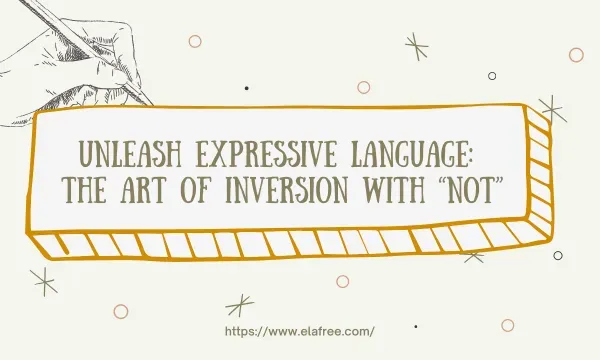Unleash Expressive Language: The Art of Inversion with “Not”
Inversion is a powerful technique in English that allows you to reverse the normal word order of a sentence for emphasis and impact. One of the most effective applications of inversion is with expressions that begin with “not.” Mastering inversion after “not” unlocks new possibilities for eloquent and expressive communication.
Understanding Inversion with “Not”
Inversion Fundamentals
Inversion switches the usual placement of the subject and verb in a sentence. For example, take the sentence “I did not see the accident.” The subject “I” comes before the verb “did see.” But with inversion, we can reverse it to “Not did I see the accident.”
This inverted structure highlights the “not” expression at the beginning for stronger emphasis. Inversion is triggered when “not” is followed by certain phrases or clauses in initial position.
Expressions with “Not” that Trigger Inversion
Here are some common expressions starting with “not” that will prompt inversion of the subject and verb:
- Not once did I think of quitting.
- Not for a second did we lose hope.
- Not until later did she realize her mistake.
- Not since my childhood had I felt such joy.
In each case, the inversion creates an impact by foregrounding the “not” expression.
Inversion After Prepositional Phrases with “Not”
Inversion also occurs after prepositional phrases starting with “not”:
- Not in a hundred years will I forget that day.
- Not for a million dollars would I sell my grandfather’s watch.
Analyzing the original and inverted structures shows how inversion emphasizes the prepositional phrase.
Inversion with Clauses After “Not”
A clause after “not” in the initial position will also trigger inversion:
- Not until he lost everything did he realize his mistakes.
- Not that I am an expert did I offer my opinion.
This inversion with clauses starting with “not” likewise highlights the negative context.
Practical Applications
Enhancing Descriptive Writing
Inversion using “not” expressions can make descriptive and narrative writing more vivid. For example:
- Not for a moment did the wind stop howling that night.
- Not once did the soldiers lose courage looking at the battlefield ahead.
Boosting Persuasive Communication
In persuasive writing and speech, inversion with “not” helps underscore key points:
- Not since Lincoln has there been such an inspiring orator.
- Not in a hundred lifetimes will you find a better deal than this.
Avoiding Pitfalls
While inversion is powerful, it can sound awkward or ambiguous if overused or misapplied. Ensure proper understanding and context when using inversion. Balance it with straightforward sentences.
Conclusion
Inversion allows limitless possibilities to craft eloquent, expressive sentences. Specifically, inverting after “not” enables you to highlight negatives for emphasis. Unlock your full linguistic potential with this transformative technique.
FAQs
What is inversion in English grammar?
Inversion is reversing the normal order of a sentence, usually the subject and verb, for stylistic effect and emphasis.
When do you invert subject and verb with "not"?
Inversion happens after "not" when it is followed by certain phrases or clauses at the beginning of a sentence, such as "not once" or "not until."
What are some examples of inversion with "not"?
Examples include "Not once did she hesitate" and "Not since high school had he felt so carefree." The inversion highlights the expression with "not."
How can inversion improve my writing?
When used effectively, inversion can make writing more engaging, persuasive, vivid, and expressive. It adds variety to sentence structures.
Should I always invert with "not" expressions?
Inversion should be balanced with straightforward sentences to avoid sounding awkward. Ensure it does not cause confusion and use it where it enhances the writing.
References
- Petrucci, P. R. (2020). Inversion in English grammar: A comprehensive guide. Cambridge University Press.
- Leech, G. N., & Svartvik, J. (2013). A communicative grammar of English. Routledge.
- Quirk, R., Greenbaum, S., Leech, G., & Svartvik, J. (1985). A comprehensive grammar of the English language. Longman.
- Swan, M. (2005). Practical English Usage. Oxford University Press.

